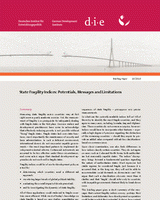State fragility indices: potentials, messages and limitations
Ziaja, Sebastian / Javier Fabra MataBriefing Paper 10/2010
Bonn: German Development Institute / Deutsches Institut für Entwicklungspolitik (DIE)
Dt. Ausg. u.d.T:
Was leisten Indizes staatlicher Fragilität
(Analysen und Stellungnahmen 5/2010)
Measuring state fragility across countries may at first sight seem a purely academic exercise. Yet, the measurementof fragility is a prerequisite for adequately dealing with fragile states in the first place. Decision makers and development practitioners have come to acknowledge that effectively reducing poverty is not possible without “fixing” fragile states. Fragile states lack core state functions, most importantly the maintenance of security and basic administration. In such a deficient environment, international donors do not encounter capable governments – the most important partners to implement development-oriented reforms. Certain aid instruments are assumed to be less effective under these circumstances, and some actors argue that standard development approaches do not work well in fragile states. Fragility indices could be of use for development policy as a tool for
• determining which countries need a different aid approach;
• monitoring larger trends of global political stability;
• evaluating the overall impact of development aid;
• and for investigating the dynamics of state fragility.
All of these applications could make aid to fragile countries more efficient. While most of today’s knowledge on state fragility is based on case studies, quantitative approaches could generate more generalizable findings to inform future policies. The applications listed above – especially the latter two, which refer to the causes and consequences of state fragility – presuppose very precise easurements. So what can the currently available indices tell us? All of them try to identify the most fragile countries, and they agree in many cases, including Somalia, Iraq and Afghanistan. These countries do not come as a surprise, however. Indices would have to incorporate other features – especially a high degree of precision regarding the distinction of the remaining countries – should they aspire to provide an added value compared with ad-hoc classifications based on common sense. Upon closer examination, one also finds differences in how indices classify certain countries. They do not agree on cases such as Cuba and North Korea, both authoritarian but reasonably capable states. The indices' discrepancy brings forward a fundamental question regarding the nature of authoritarian states: Must repressive but stable regimes be considered fragile, just because it is assumed that, in the long run, they will not be able to accommodate social demands as democracies can? We argue that such a classification obscures more than it clarifies and that ‘fragile’ should refer only to countries with incapable governments that are likely to break down soon. This briefing paper gives a short summary of the messages that current fragility indices convey, portrays their limitations and delineates how development cooperation could better exploit their potential. It shows how current indices can be applied, and how both policy makers and researchers can contribute to improving future indices for ultimately supporting development in fragile states.


